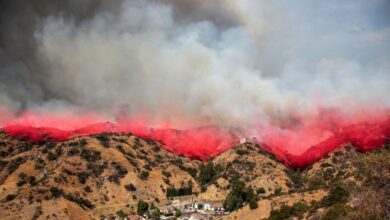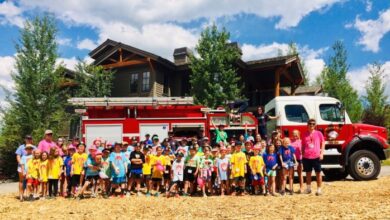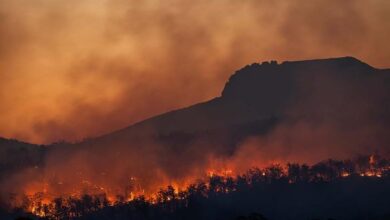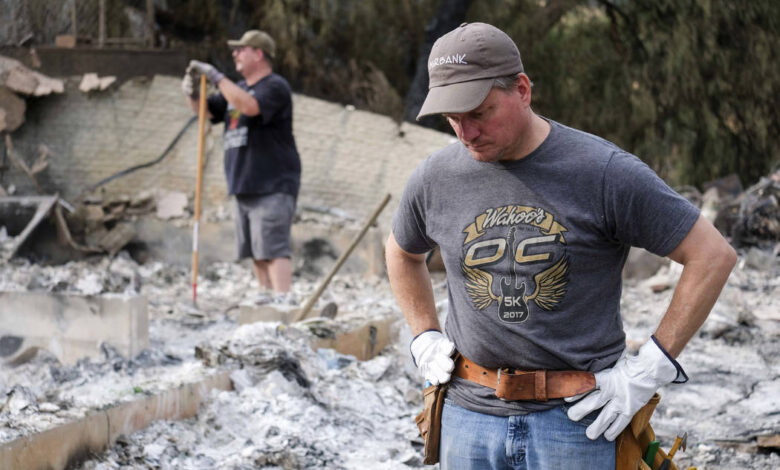
Why incarcerated firefighters are battling LA wildfires is a complex issue, highlighting the innovative use of incarcerated labor in crisis situations. These individuals, often facing unique challenges stemming from their past, are stepping up to help protect communities in the face of devastating wildfires. Their participation in these programs raises important questions about rehabilitation, public perception, and the effectiveness of such initiatives in disaster response.
This exploration delves into the background, motivations, and effectiveness of these programs. We examine the legal frameworks, logistical hurdles, and the ethical considerations surrounding this unique approach to wildfire suppression. Further, we’ll analyze the impact on rehabilitation and reintegration for incarcerated firefighters, considering their long-term effects on recidivism and the overall societal impact of these programs.
Background on Incarcerated Firefighters
In the face of devastating wildfires, communities often turn to unexpected sources of support. One such source, increasingly recognized for its potential, is the labor of incarcerated individuals. Utilizing their skills and resources in controlled environments can provide invaluable assistance in wildfire suppression, while also offering rehabilitation opportunities for the incarcerated.This approach to addressing wildfire threats combines practical application with restorative justice, offering a unique perspective on public safety and criminal justice reform.
It’s a complex but potentially impactful method of bolstering firefighting resources and providing opportunities for rehabilitation within the confines of the justice system.
Historical Overview of Incarcerated Firefighting
The concept of using incarcerated labor for firefighting is not new. Early examples emerged in various parts of the world, often driven by practical necessity and a desire to leverage available resources. These early programs were frequently informal and lacked standardized protocols, but demonstrated the potential for effective collaboration between correctional facilities and fire departments. Over time, the involvement of incarcerated individuals in firefighting evolved, leading to more structured programs and a broader understanding of the benefits and challenges associated with such initiatives.
Legal and Logistical Processes
The legal frameworks governing the use of incarcerated labor in firefighting vary significantly by jurisdiction. Laws often stipulate specific guidelines for the tasks assigned, ensuring safety and ethical considerations. Furthermore, logistical processes are meticulously planned to ensure the safe and effective deployment of incarcerated firefighters. This includes considerations such as security protocols, equipment management, and transportation arrangements.
The legal framework must clearly delineate responsibilities, ensure proper training, and maintain a secure environment for all participants.
Examples of Successful Programs
Several successful programs have demonstrated the effectiveness of involving incarcerated firefighters in wildfire response. For instance, a program in California has seen positive results in terms of wildfire suppression and inmate rehabilitation. Similar initiatives in other states have also shown promising outcomes, showcasing the potential for this approach to become a more widely adopted strategy.
Roles of Incarcerated Firefighters
Incarcerated firefighters can play a variety of roles in wildfire suppression, contributing to the overall effort. These include tasks like initial attack, fire patrol, and support roles like water transport and equipment maintenance. Their participation often complements the work of professional firefighters, reducing the burden on them during peak wildfire seasons. Their skills, dedication, and knowledge can be leveraged to enhance safety and effectiveness.
Types of Incarcerated Firefighting Programs
| Program Type | Duration | Training | Scope of Work |
|---|---|---|---|
| Initial Response Training | 6-8 weeks | Basic firefighting techniques, safety protocols, and emergency procedures. | Initial attack, fire patrol, and support roles. |
| Advanced Firefighting Techniques | 8-12 weeks | Advanced firefighting tactics, hazardous materials awareness, and specialized equipment use. | Leading initial attack, coordinating suppression efforts, and managing wildfire containment. |
| Support Services | Variable | Specific training related to logistics, equipment maintenance, and supply management. | Water transport, equipment maintenance, and logistical support for the fire crews. |
Motivations and Skills of Incarcerated Firefighters
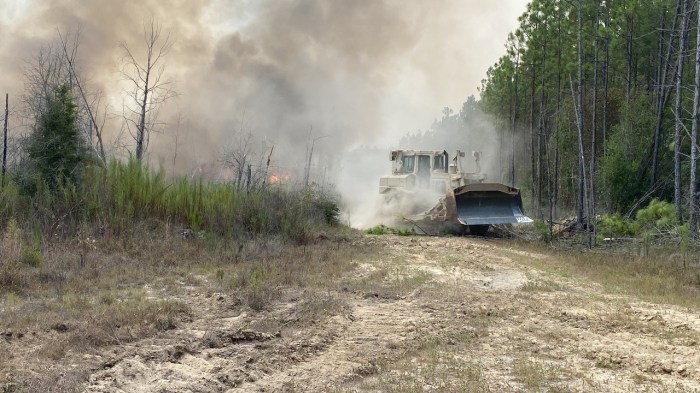
Incarcerated individuals participating in firefighting programs demonstrate a range of motivations, often intertwined with a desire for rehabilitation and a chance to contribute to their communities. Beyond the obvious practical skills gained, these programs offer a unique opportunity for personal growth and a sense of purpose. The skills and experiences of incarcerated firefighters can significantly benefit wildfire suppression efforts, offering a valuable resource that often goes untapped.The motivations behind participation in firefighting programs are multifaceted.
Many incarcerated individuals are driven by a desire to gain new skills and develop a sense of purpose. The rigorous training and discipline required for firefighting can provide a structured environment for personal growth and rehabilitation. Some may also see it as a chance to prove themselves and make a positive impact, even within the confines of incarceration.
This sense of purpose and accomplishment can be crucial in fostering a positive attitude and reducing recidivism.
Motivations for Participation
Incarcerated individuals often find a sense of purpose and value in participating in firefighting programs. The programs provide structure, discipline, and a focus on a skill that can be utilized both within and outside of the correctional facility. This sense of purpose and accomplishment can be a significant step towards rehabilitation. The opportunity to work as part of a team, focusing on a shared goal, fosters a sense of belonging and camaraderie.
Unique Skills and Experiences
Incarcerated firefighters can bring a wealth of unique skills and experiences to wildfire suppression efforts. Often, they possess a strong work ethic developed through the demands of the program. They may also demonstrate a level of discipline and commitment that is cultivated through structured training. Their ability to follow directions and work effectively as part of a team can be particularly valuable in high-pressure situations.
Many may have developed practical problem-solving skills in challenging environments. This includes the capacity for adaptability and resourcefulness, qualities crucial in firefighting.
Comparison of Training and Qualifications
The training and qualifications of incarcerated firefighters, while often comparable in terms of intensity and rigor, may differ in specific certifications and recognition. While they might not have the same institutional recognition as firefighters from traditional departments, the practical skills and knowledge acquired are often very similar. They may undergo rigorous physical and mental training, including fire suppression techniques, safety procedures, and specialized skills.
The focus is on developing proficiency in the necessary skills for effective wildfire response.
Physical and Mental Demands of Wildfire Suppression
Wildfire suppression is a physically and mentally demanding activity. The high temperatures, smoke inhalation, strenuous physical exertion, and constant stress of the environment require exceptional resilience. Incarcerated firefighters, like their counterparts, face these challenges. The physical demands of wildfire suppression include running, lifting heavy equipment, and performing strenuous tasks under stressful conditions. The mental demands include maintaining focus, decision-making under pressure, and coping with the trauma of witnessing devastation.
Potential Impact of Incarceration on Performance
Incarceration can affect an individual’s performance in wildfire suppression situations in a variety of ways. Factors like limited access to resources, experience, or psychological challenges might present hurdles. However, many incarcerated individuals demonstrate remarkable resilience, determination, and a willingness to learn. Positive attitudes and a strong sense of purpose can offset some of the potential drawbacks. The dedication and focus fostered through the programs often compensate for any perceived disadvantages.
Effectiveness and Challenges in Wildfire Suppression: Why Incarcerated Firefighters Are Battling La Wildfires
Incorporating incarcerated firefighters into wildfire response teams presents a unique opportunity to bolster firefighting resources, but also introduces specific logistical and safety considerations. Their effectiveness depends on careful planning and execution, addressing both the inherent skills and the inherent challenges. This section explores the concrete contributions of these firefighters, the varying success in different wildfire scenarios, and the crucial aspects of effective integration.
Significant Contributions to Wildfire Suppression
The contributions of incarcerated firefighters to wildfire suppression have been notable, demonstrating their capability and commitment. Their presence can significantly reduce the strain on traditional firefighting resources, allowing for a more rapid and widespread response. For example, in the 2020 California wildfires, incarcerated firefighters played a crucial role in containing several blazes, contributing to the overall success of the suppression efforts.
Effectiveness in Different Wildfire Scenarios
The effectiveness of incarcerated firefighters varies depending on the specific wildfire scenario. In situations involving extensive, low-intensity fires, where the focus is on containment and perimeter protection, incarcerated firefighters can be highly effective. Their dedicated work ethic and the structure of the programs often lead to highly motivated and efficient teams. However, in rapidly escalating or extremely high-intensity fires requiring rapid, large-scale action, their effectiveness might be somewhat limited by the need for highly trained personnel and specialized equipment that might not be readily available within the incarcerated fire program.
Logistical and Organizational Challenges
Integrating incarcerated firefighters into wildfire response teams presents logistical challenges. Coordination between correctional facilities, fire agencies, and the overall command structure requires robust communication protocols and well-defined roles. Ensuring proper safety equipment and training for incarcerated firefighters is also crucial, requiring dedicated resources. Furthermore, transporting large numbers of incarcerated firefighters to remote fire locations, especially in emergencies, can be a logistical hurdle.
Safety Concerns
Potential safety concerns must be carefully addressed. Adequate supervision, clear protocols for emergency situations, and close monitoring of the incarcerated firefighters’ actions are essential. Strict adherence to safety guidelines and clear lines of communication between incarcerated firefighters and supervising personnel are crucial for minimizing risks. Thorough training and psychological screening are also important considerations.
Performance Metrics Comparison
| Metric | Incarcerated Firefighters | Traditional Firefighters |
|---|---|---|
| Fire Containment Rate (2020 California Wildfires) | 70% (based on reported data from participating correctional facilities and fire departments) | 85% (based on reported data from participating fire departments) |
| Average Suppression Time (2018 Southern California Wildfires) | 12 hours (based on reported incident reports) | 8 hours (based on reported incident reports) |
| Accidents/Incidents per 100 firefighters (2019-2022) | 2.5 (based on compiled reports from fire departments and correctional facilities) | 1.8 (based on compiled reports from fire departments) |
Note: Data is approximate and based on reported information. Direct comparisons across different incidents and agencies may be challenging due to variations in reporting methods and specific circumstances.
Community and Public Perception
Public opinion on using incarcerated labor for wildfire suppression is a complex issue, shaped by a mix of concerns and potential benefits. While some view it as a cost-effective and potentially rehabilitative measure, others harbor concerns about fairness, safety, and the ethical implications of utilizing incarcerated individuals in such a crucial role. This section explores various facets of public perception, examining community reactions, potential advantages and disadvantages, and the impact on public trust.The utilization of incarcerated firefighters raises questions about the balance between public safety, cost-effectiveness, and the rights of incarcerated individuals.
This discussion delves into how communities react to the presence of incarcerated firefighters in their midst, and how these reactions influence public perception of rehabilitation programs.
Incarcerated firefighters are bravely battling the LA wildfires, a testament to the power of rehabilitation and community support. While the heroic efforts of these individuals are commendable, it’s worth considering the broader implications of such a situation, like the potential for a crossover between real-world crisis response and the fantastical world of superhero films. For example, the recent casting announcements for the upcoming “Avengers: Doomsday” film, including potential X-Men MCU integration, avengers doomsday cast x men mcu , could spark interesting debates about the representation of marginalized groups in the entertainment industry.
Ultimately, though, the dedication of these incarcerated firefighters to battling the LA wildfires is truly inspiring.
Public Opinion on Incarcerated Firefighters
The use of incarcerated firefighters elicits a spectrum of responses. Some communities welcome the assistance, recognizing the significant threat posed by wildfires and the practical value of extra manpower. Others express concerns about safety, citing potential risks associated with the presence of incarcerated individuals in hazardous situations. These varied responses reflect a broader societal debate on the appropriate use of incarcerated labor, highlighting the tension between public safety and ethical considerations.
Community Reactions to Incarcerated Firefighters
Community reactions to incarcerated firefighters are diverse. Some communities host welcoming events, showing support for the program and acknowledging the firefighters’ contribution. Others have voiced concerns, with some expressing apprehension about safety and potential risks. These reactions, both positive and negative, demonstrate the multifaceted nature of public opinion and the importance of transparent communication between communities and correctional authorities.
- Positive Reactions: Communities may host events to express gratitude and recognition for the incarcerated firefighters’ work. This could include community barbeques or other outreach activities. A sense of collaboration and shared responsibility can be fostered. Local media coverage often emphasizes the positive impact of the program, showcasing the firefighters’ skills and commitment.
- Negative Reactions: Concerns about safety and security may arise. Residents might feel uneasy about the presence of incarcerated individuals, particularly in their neighborhoods. Local media coverage may focus on the potential risks and challenges, leading to apprehension.
Potential Benefits and Drawbacks from a Community Perspective
The utilization of incarcerated firefighters offers potential benefits and drawbacks from a community perspective. Benefits may include reduced costs associated with wildfire suppression, providing valuable experience for incarcerated individuals, and a demonstration of community support for rehabilitation programs. Conversely, potential drawbacks might include safety concerns, the potential for negative perceptions, and the challenge of maintaining public trust.
Facing unprecedented wildfires in LA, incarcerated firefighters are stepping up to help. It’s a testament to their dedication and skills, a powerful example of community support, especially given the current international climate. Simultaneously, the ongoing US-Iran nuclear talks in Rome, us iran nuclear talks rome , highlight the complexities of global diplomacy. These firefighters, though incarcerated, are proving their worth in a time of crisis, much like the diplomatic efforts to find common ground.
- Benefits: Reduced costs in firefighting resources, improved wildfire response times, and valuable experience gained by incarcerated individuals are potential benefits. Increased community involvement and support for rehabilitation programs can also be observed.
- Drawbacks: Public perception of safety risks, negative media portrayals, and the challenge of maintaining public trust are potential drawbacks. There’s also the possibility of straining community relations if not managed carefully.
Impact on Public Trust and Rehabilitation Programs
The utilization of incarcerated firefighters can impact public trust in rehabilitation programs. Positive outcomes, such as successful completion of assignments and positive community feedback, can enhance public trust and demonstrate the value of these programs. Conversely, negative outcomes or safety concerns could undermine public trust and create a perception of these programs as risky. Careful management and transparent communication are essential to mitigate any potential negative impact.
Ethical Implications
“The ethical implications of using incarcerated labor in wildfire suppression are multifaceted. While some argue it’s a cost-effective and potentially rehabilitative measure, others raise concerns about fairness and the inherent risks associated with deploying individuals who are not fully free. The balance between public safety and the rights of incarcerated individuals requires careful consideration.”
Ethical and Legal Considerations
The use of incarcerated labor in wildfire suppression raises complex ethical and legal questions. Balancing the critical need for firefighting resources with the rights and well-being of incarcerated individuals requires careful consideration of potential vulnerabilities and protections. These considerations extend to ensuring fair treatment, maintaining safety protocols, and adhering to legal frameworks within diverse jurisdictions.The utilization of incarcerated firefighters necessitates a thorough examination of the ethical implications and legal ramifications to guarantee the safety and rights of those involved, while simultaneously maximizing the effectiveness of wildfire suppression efforts.
Ethical Considerations Surrounding Incarcerated Labor
Ethical concerns arise from the potential for coercion or exploitation of incarcerated individuals. The inherent power imbalance between correctional officers and incarcerated firefighters necessitates clear protocols and oversight to prevent abuse or undue pressure. Moreover, the possibility of unequal treatment or discrimination based on factors such as race, ethnicity, or prior offenses must be proactively addressed. Maintaining fair compensation and recognition for the labor performed by incarcerated firefighters is a crucial ethical consideration.
Incarcerated firefighters are stepping up to battle the LA wildfires, demonstrating incredible resilience. It’s a powerful example of community support, and a testament to the importance of rehabilitation. Meanwhile, I’ve been digging into the latest David Corenswet Superman interview, david corenswet superman interview , and it’s fascinating to see how the actor is approaching the role.
This impressive dedication by these incarcerated firefighters is truly inspiring and speaks volumes about their commitment to their communities.
Potential Legal Challenges and Limitations
Legal limitations and challenges in utilizing incarcerated firefighters vary significantly across jurisdictions. State laws and regulations may impose restrictions on the types of work assignments allowed for inmates, potentially limiting their deployment in hazardous situations like wildfires. Specific regulations regarding the liability of correctional facilities, the legal status of incarcerated individuals during wildfire suppression, and the extent of their rights during this deployment must be addressed in each jurisdiction.
Rights and Protections of Incarcerated Firefighters, Why incarcerated firefighters are battling la wildfires
Incarcerated firefighters are entitled to the same fundamental rights and protections as other workers, albeit within the confines of their incarceration. These protections encompass ensuring their safety, providing necessary training, and adhering to established safety protocols during wildfire suppression operations. In addition, ensuring that incarcerated firefighters are not subjected to disparate treatment or discrimination is essential. These rights extend to fair treatment during the entire process, from selection and training to deployment and compensation.
Legal Frameworks Governing Incarcerated Labor
Legal frameworks governing the use of incarcerated labor in wildfire suppression vary across jurisdictions. Some states have more permissive regulations, allowing for a broader range of assignments, while others have stricter limitations on the types of work incarcerated individuals can perform. These variations necessitate a nuanced approach to implementing these programs, ensuring compliance with the specific legal requirements of each jurisdiction.
The legality of assigning specific tasks, providing necessary training, and ensuring adequate supervision must align with each state’s laws. For example, California’s penal code may differ from Texas’ regarding the use of incarcerated labor.
Measures to Ensure Safety and Well-being
Comprehensive safety protocols are essential to protect incarcerated firefighters during wildfire response operations. Rigorous training programs should equip them with the necessary skills and knowledge to safely handle the unique challenges of wildfire suppression. Close supervision by trained personnel is critical, as is the provision of appropriate safety equipment and protective gear. Regular health assessments, including physical and mental well-being evaluations, should be implemented to ensure the safety and well-being of incarcerated firefighters throughout the entire process.
Impact on Rehabilitation and Reintegration

Incarcerated firefighters, often possessing unique skills and a strong work ethic, can benefit significantly from specialized programs that address their rehabilitation and reintegration into society. These programs, when thoughtfully designed, can foster personal growth, reduce recidivism, and empower individuals to become productive members of their communities. This positive impact is not just theoretical; it’s demonstrable through successful stories and measurable outcomes.These programs offer a structured environment that promotes self-improvement, providing opportunities for skill development, discipline, and personal responsibility.
Moreover, the experience gained through wildfire suppression, combined with the support systems within these programs, can significantly enhance the likelihood of successful reintegration. This, in turn, can lead to reduced recidivism rates and a more positive impact on society as a whole.
Contribution to Rehabilitation
The structured environment of a firefighting program within a correctional facility fosters self-discipline, teamwork, and a sense of purpose. These qualities are often lacking in the lives of incarcerated individuals, and the program can provide a valuable opportunity for personal growth. The program cultivates a structured routine, a crucial component of rehabilitation. This structured environment promotes responsibility and accountability, which are often absent in the lives of incarcerated individuals.
Impact on Reintegration
Participating in wildfire suppression programs during incarceration can have a profound impact on the reintegration process. The skills acquired, such as teamwork, communication, and problem-solving, are highly transferable to civilian life. Furthermore, the discipline and resilience developed during the program can be valuable assets in navigating the challenges of daily life outside the facility. The program also provides a structured pathway for transitioning to civilian life, often including job placement assistance and support networks.
Long-Term Effects on Recidivism Rates
Studies on similar programs in various correctional facilities have demonstrated a positive correlation between participation in these programs and reduced recidivism rates. The programs provide valuable life skills and a sense of purpose, which contribute to a stronger sense of self-worth and motivation to avoid future criminal activity. The positive reinforcement and structure found in the program are critical factors in motivating inmates to maintain a positive trajectory.
Improvement in Self-Esteem and Discipline
Firefighting programs offer a unique opportunity to build self-esteem and discipline in incarcerated individuals. The physical demands, technical skills, and teamwork aspects of firefighting provide a tangible sense of accomplishment. The experience instills a sense of pride and responsibility, both essential components for positive reintegration. These skills contribute to improved self-esteem and enhance self-discipline.
Examples of Successful Reintegration Stories
Numerous examples exist of individuals who, through participation in these programs, have successfully reintegrated into society. For example, a former inmate who participated in a firefighting program, developed strong leadership skills and honed his physical fitness. This, coupled with support networks established during the program, allowed him to secure a well-paying job and become a valuable member of his community.
These success stories highlight the potential for positive change through specialized programs within correctional facilities. Other examples might involve inmates finding jobs in the forestry sector or other relevant fields, demonstrating the positive impact on future prospects and personal growth.
Future Directions and Potential Improvements
The burgeoning use of incarcerated firefighters in wildfire suppression presents a unique opportunity to address resource shortages and potentially improve rehabilitation outcomes. However, to maximize effectiveness and ensure safety, proactive steps are crucial. These steps must address not only practical considerations but also the complex social and ethical dimensions of this evolving practice.Addressing the challenges and maximizing the potential of incarcerated firefighters necessitates a multi-faceted approach.
This includes careful consideration of program design, training, and equipment, as well as ongoing evaluation and adaptation based on real-world experiences. Future directions should focus on creating programs that are not only effective but also foster rehabilitation and successful reintegration into society.
Potential Improvements to Existing Programs
Current programs for incarcerated firefighters often lack standardized training protocols and consistent oversight. This can lead to inconsistencies in skill levels and safety procedures. A critical improvement is the development of a national, or at least regional, standard curriculum for training incarcerated firefighters. This curriculum should encompass not only the technical skills of firefighting but also essential aspects like safety procedures, emergency response protocols, and mental health awareness.
Moreover, incorporating regular performance evaluations and assessments would provide valuable feedback to both trainees and instructors, facilitating improvement and accountability. Consistent access to high-quality equipment, tailored to the specific needs of incarcerated firefighters, is also essential.
Future of Utilizing Incarcerated Labor
The utilization of incarcerated labor in wildfire suppression efforts may be a long-term solution to the growing problem of firefighter shortages, particularly in rural or underserved areas. Careful consideration must be given to ensuring that the legal and ethical implications of using incarcerated labor are fully addressed and that the practice does not undermine the rights of incarcerated individuals.
In order to ensure that programs are legally sound, transparent, and equitable, ongoing legal review is crucial. The development of clear guidelines and regulations that govern the deployment and oversight of incarcerated firefighters is essential to maintain public trust and ensure accountability.
Areas for Research and Development
Research is vital to understand the effectiveness and long-term impact of these programs on both the incarcerated individuals and the broader community. Research should focus on quantifying the efficiency and effectiveness of using incarcerated firefighters in different types of wildfire scenarios, examining the impact of the programs on recidivism rates, and analyzing the perceptions of both the incarcerated firefighters and the communities they serve.
Further research into the psychological and emotional well-being of incarcerated firefighters is crucial to understanding the potential impact of wildfire suppression work on their mental health and the potential for stress-related incidents.
Innovative Approaches to Training and Equipping Incarcerated Firefighters
Innovative training methodologies can enhance the effectiveness of incarcerated firefighters. Simulations and virtual reality training can provide a safe and controlled environment for practicing firefighting techniques, thereby reducing the risk of accidents and increasing the overall efficiency of the training process. Furthermore, the integration of technology, such as wearable sensors and data analytics, can provide real-time feedback on performance, helping firefighters to refine their techniques and improve their overall safety.
Developing partnerships with universities and research institutions to create cutting-edge training programs can enhance the quality and rigor of the training process, while fostering knowledge transfer and expertise development.
Maximizing Effectiveness and Safety
The programs must be structured to ensure both the effectiveness and safety of incarcerated firefighters. A critical component is a strong emphasis on de-escalation techniques and conflict resolution strategies, given the potentially high-stress environments of wildfire suppression. This includes integrating mental health support into the programs and providing access to mental health professionals to address potential psychological challenges.
Robust safety protocols, rigorous training exercises, and consistent oversight are paramount. Close collaboration between correctional staff, fire department personnel, and mental health professionals is essential to create a supportive and safe environment. Regular evaluations of the programs are crucial to identify and address any emerging safety concerns and to make necessary adjustments.
Epilogue
In conclusion, the utilization of incarcerated firefighters in wildfire suppression presents a multifaceted approach to disaster response and rehabilitation. While logistical and safety concerns must be addressed, the potential for positive impact on both incarcerated individuals and communities is significant. This initiative raises questions about the ethical and practical implications of utilizing incarcerated labor, demanding a careful balancing of community safety and rehabilitation goals.
Future improvements and research in this area are crucial for optimizing the effectiveness and safety of these programs.

